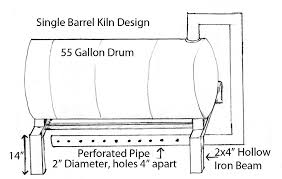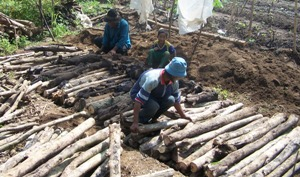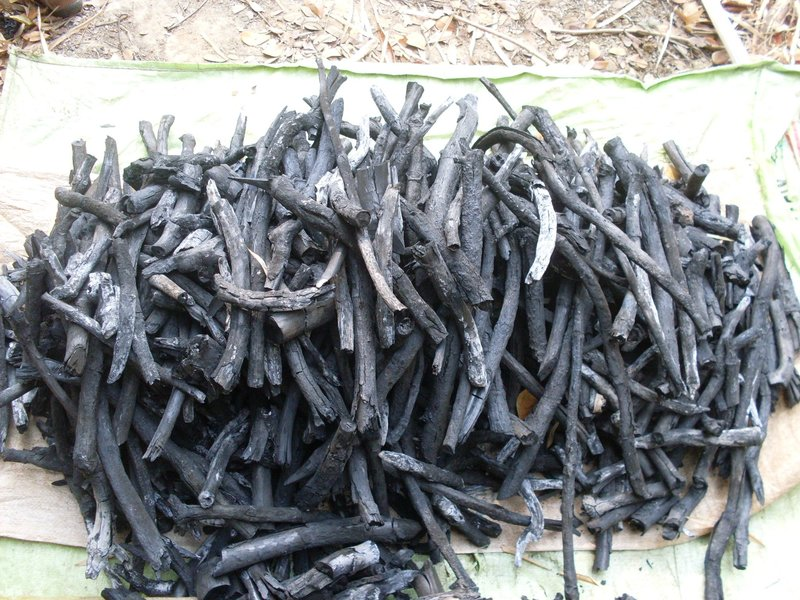
1) POWER
If you live in a rural area—or even the outskirts of suburbia—and have a lot of wood near you, you can use that wood to power your house, car, generator, and any kind of combustion engine.
I hope it doesn't come to this, but in case it does, this thread is for you!
If you live in a rural area—or even the outskirts of suburbia—and have a lot of wood near you, you can use that wood to power your house, car, generator, and any kind of combustion engine.
I hope it doesn't come to this, but in case it does, this thread is for you!

2) in 2014, I moved to the least populated (per capita) jungle in Mexico, so I could take my inventions and try my hand at living outside government interference.
If you've ever seen the movie, "Mosquito Coast," w/ Harrison Ford, that's what my family did for 7 years.
If you've ever seen the movie, "Mosquito Coast," w/ Harrison Ford, that's what my family did for 7 years.

3) Ice from fire... Or whatever you want... And the machine that makes it doesn't have to be 3 stories tall.
The technology is called gasification. it simply means that a gaseous fuel can be made from solid fuel. Wood chips, wood pellets—or better yet—charcoal.
The technology is called gasification. it simply means that a gaseous fuel can be made from solid fuel. Wood chips, wood pellets—or better yet—charcoal.
4) Making coffee... Gonna be a long thread. Give me 10 mins.
5) Ok... so here is the top line. Anyone can make this machine and anyone can operate it. All parts can be found at your local Home Depot or junk yard.
You might need a few hours help from your local welder, however.
Budget = less than $1,000
You might need a few hours help from your local welder, however.
Budget = less than $1,000
6) Before I left California in 2014, I had gone through 5 prototypes. Most of them were ugly as sin, but they all worked.
Here was the initial concept drawing:
Here was the initial concept drawing:

7) Turns out that most of these subsystems weren't even needed... Sure, for optimum performance you'd probably want to have all these things on your system, but they're not all necessary.
Emergency gasifiers just need to run.
Emergency gasifiers just need to run.
9) And here is a photo of the actual result, made with a shop vac, couple of buckets, and an old propane tank used at the hopper. We built it on a motorcycle trailer so it could be mobile... 

10) this little unit would make up ~10,000 Watts in power, which is enough gas to run your Generator. Direct for big power, or charge your battery bank... Up to you.
11) And here is (a much heavier) me teaching a gasification class to a group of off-gridders before I left society... Nice shirt, huh? Looks good with that propane torch in my hand. 

12) Of course, 10kW is a lot of power, but it won't run your car... Big Daddy T need more power!
Hence, prototype #2:
Hence, prototype #2:

13) Now, if your read my Trump greatest actor thread, you'll remember how I came to understand that hydrogen was most likely used on those craft... And the reason it was clear to me was because I attempted something outlined in a very old book by Philip Litherland Teed (1919) 

14) Page 78 archive.org/details/chemis…
15) What does hydrogen have to do with gasification? Nothing. Nearly all gasifiers will make carbon monoxide (CO), and although very harmful if inhaled, it burns quite nicely—like propane. NEVER do this indoors.
16) However, I wanted to try what i read in Teed's book... That is, if you "steam" water onto a hot bed of coals, something amazing happens... Carbon is a catalyst, and at high temperatures, you can rip H20 down to its monoatomic parts... That would be H2 + O
17) Indulge me a bit... The science isn't as important to understand as the concept... You don't need to know any of this chemistry to build or operate a gasifier, but I want to show you how to get "free energy" from water.
Let me explain...
Let me explain...
18) However, instead of doing it in batches like the English system of the early 20th century, I figured what if there was a constant "leak" of steam—always on, but not enough to snuff out the hot coals. That way, you could fire your gasifier up, turn on the "drip" and walk away.
19) It worked! In fact, it worked so well that it earned my partner and I a visit by the "men in black." Luckily, I had already moved to Mexico when this happened, but it scared the sh!t out of my partner. Black suburban and all... Our short venture died that day.
20) I'm going to share some videos with you of my partner, and my real name is mentioned in these videos... But screw it!
My name is Troy. Nice to meet you.
My name is Troy. Nice to meet you.
21) Part 1: Water to Fuel
22) Part 2: Water to Fuel
23) Part 3: Water to Fuel
24) Part 4: Water to Fuel
Pay close attention to this and #5... Magic!
Pay close attention to this and #5... Magic!
25) Part 5: Water to Fuel
BOOM!
BOOM!
26) Part 6: Water to Fuel (final)
27) Remember when I said most of this stuff isn't needed? Well... We hadn't learned our lesson yet. Instead, we fixed the design, and focused on making it a "sellable" product. After another prototype or two, we were able to shrink the system by half the size w/o any loss of BTUs
29) And here is a video of us testing the unit... I flew back to So Cal for a conference where i was the speaker, and we brought the machine to the event... I'm on camera. We were running a standard 7.5kW genset... It ran for about 3 hours straight.
30) And finally, here was our (cheap) attempt at making a promo video... This was all right before our "visit" from those lovely gentlemen in government :)
Yeah, yeah... Bunch of "carbon in the atmosphere" talk to appease the "greenies."
Yeah, yeah... Bunch of "carbon in the atmosphere" talk to appease the "greenies."
31) Ok... Done w/ the history...
Now let's talk about how you can make one, how it works, and how to NOT over-engineer it like we did. That final design cost us about $3K in parts and material... Was going to try to sell it for about $6K...
You can make one, for a fraction.
Now let's talk about how you can make one, how it works, and how to NOT over-engineer it like we did. That final design cost us about $3K in parts and material... Was going to try to sell it for about $6K...
You can make one, for a fraction.
32) If you've read this far, you either want to be entertained, or you're interested in making one.
If there is no gas at the pump, or the grid goes down, this machine may keep you alive. Again, I hope it doesn't come to that, but it is indeed the purpose of this thread.
If there is no gas at the pump, or the grid goes down, this machine may keep you alive. Again, I hope it doesn't come to that, but it is indeed the purpose of this thread.
33) Ok... I'll make this as simple as I can... But this is the part where we need to get a little technical.
34) First, don't use wood chips or pellets like many others in the micro-gasification camp. 95% of DIY home gasifiers use wood as fuel. Not a good idea for emergencies, because you need to "baby" the gasifier.
Why?
Why?
35) Because wood burns twice. First, the flame you see in your fireplace is the gas that's inside the wood... The lignin, the cellulose, and the hemi-cellulose. About half the BTUs come from the stuff in between the wood fibers.
36) The other half of the BTUs come from the charcoal that remains after the "gas" is already burned off... Hence the hot coals you see after the flame dies.
37) If I say "hence" one more time, feel free to smack me. Ok, moving on...
Why not wood? Wood also holds water. That's why anyone storing firewood wants it to be "bone dry." It needs to cure.
Takes an incredible amount of energy just to get the water out of the wood.
Why not wood? Wood also holds water. That's why anyone storing firewood wants it to be "bone dry." It needs to cure.
Takes an incredible amount of energy just to get the water out of the wood.
38) Wood chips have a much greater surface area than firewood, and because of that—unless you live in a desert—the humidity in the air will be soaked up like a sponge. Not good. Even MORE curing needed.
You'll also need a wood chipper for wood chips. Also not ideal.
You'll also need a wood chipper for wood chips. Also not ideal.
39) Also, the wood you chip can come in all densities, and you'll get varying densities in the wood itself... I.e. balsa wood would burn too quick to be very useful... Pine, oak, walnut shells... all good and fairly dense. Denser the better.
40) if you just happen to own a pelletizer, it doesn't matter what kind of wood you use, because it is mechanically compressed to the same density. Even bamboo can be made dense with a pelletizer. But who the hell owns a pelletizer? Not me... No good.
41) And finally, the BIGGEST reason not to use wood chips or wood pellets, is because the chips are all different shapes and sizes, and this causes "bridging." Bridging is when the material gets hung up on itself and creates gaps in the hopper. Happens all the time.
42) Most gasifier enthusiasts don't mind the bridging so much because they are hobbyists, and smacking the side of the hopper will collapse the voids caused by bridging. That's what I mean by "babying" it. But you want it to just work, even if you're not next to it.
43) Ok, Troy, so can I just run down to the store and buy some Kingsford charcoal?
Nope. The size of those briquettes are WAY too big, and they are "formed," with binders and chemicals, etc. Won't work.
You need to make your own! But don't worry... it's easy.
Nope. The size of those briquettes are WAY too big, and they are "formed," with binders and chemicals, etc. Won't work.
You need to make your own! But don't worry... it's easy.
44) So how the hell do you make charcoal? There are many methods, and I'll share a few before showing you the easiest way.
In fact, if you make a big batch, it can last you an entire month! So yes, it sucks you have to make your own, but that's just how it is. Half day event.
In fact, if you make a big batch, it can last you an entire month! So yes, it sucks you have to make your own, but that's just how it is. Half day event.
45) 10 min. dinner break... BRB... hang tight!
46) Ok, back... Let's talk about making charcoal. Charcoals are made in kilns. here's a few old-school kilns—age-old way to make charcoal. But who has time to build a kiln? No good... 

47) At some point, someone said, "Hey, let's make a kiln out of metal!" Smaller, easier to move, etc... this is an improvement, but still not ideal... 

48) Then somebody smart came up with the "double barrel retort" kiln, and variations of it... much better! But STILL not ideal... 





49) The idea of the barrel kiln is that you burns a fire around your feedstock, and the heat of the outside fire cooks the gasses off the wood without burning it. No oxygen is in the inside barrel, just pipes so the gas can escape and leave you w/ charcoal.
50) Finally, they came up with the Kontiki kiln, and it works in an entirely different way. Rather than having barrels within barrels, you merely start a fire, and when it starts to look like charcoal, you add another layer on top, thus starving the layer underneath of O2. 







51) NOW we're cooking w/ gas! But this is still a bit expensive to make, and your batch size is limited to the size of your metal container... Remember, once at the top, it needs to be covered with sheet metal to prevent the charcoal form burning to ash. You have to smother it.
52) Finally, this is my recommended way to make charcoal... Huge batches, and low cost... It's basically a pit dug into the ground, using the Kontiki method.
Your wallet feel any better?



Your wallet feel any better?




53) Critical point. You still need to smother the pit. And I mean COMPLETELY smother it with no way for ANY outside air to get in... Otherwise, you'll wake up to a pile of ash. The downside of this method is in the smothering.
Here is my suggestion...
Here is my suggestion...
54) Dig your pit deep and make it rectangular... Lay a piece of plywood down as the template and start digging... 3 feet deep is good... You can line the pit with bricks if you want for better performance, but not necessary.
55) When you get close to the top w/ charcoal and the flames are gone, you still have red hot coals, and because the flame isn't robbing O2 from the top layer, all layers will start to burn. So, it's important to smother it right away.
But how?
But how?
56) I'd invest in some sheet metal as the "lid." Or corrugated metal roofing panels... Both are cheap. Try to go thicker... Still an enormous amount of heat coming up from the char... Thicker is better... 





57) Might even be a good idea to fasten some kind of hinge on the lid, so it will fall in the exact same place as the pit. (make sure pit is slightly smaller than sheet metal... Trying to "throw" the sheet metal on w/ that heat is tricky... better to "hinge it" somehow.
58) Once closed, have a shovel and a pile of dirt (not sand) near the pit, and start covering... Cover everything... On top, but the edges are where the leakage will happen. Make sure the dirt seal is many inches think on all sides. Air is a sneaky bastard.
Call it a day.
Call it a day.
59) In the morning, the pit will be ambient temperature, and instead of ash, you'll have an abundance of BEAUTIFUL black charcoal!
Almost there... Now we have to crush it and run it through a sieve.
Almost there... Now we have to crush it and run it through a sieve.

60) Ok folks, it's getting late here, and the boss says it's time for me to come to bed... I'll pick back up in the morning, and will walk you through sizing the charcoal, and then move onto the gasifier itself. How it works, etc.
Good night all...
Good night all...
61) Well, It's 11:48AM here, so technically, it's still morning. ready to continue?
Now you have all this beautiful charcoal, but they'll be all different sizes, depending on the branches you used. The gasifier requires a very strict particles size range.
Now you have all this beautiful charcoal, but they'll be all different sizes, depending on the branches you used. The gasifier requires a very strict particles size range.
62) The good news is that charcoal is brittle. We'll need to break the bigger branches down to a smaller size. This is best done with something like a hammer.
Just smack the pieces into smaller sizes. Not too small. Bottom left is about right, but top left is where we're going.

Just smack the pieces into smaller sizes. Not too small. Bottom left is about right, but top left is where we're going.


63) The best size range for charcoal gasification is anywhere between the size of a bean, all the way up to the size of a sugar cube. Anything in that range is great, and having the various sizes (within range) is good to keep the gaps small when you fill your hopper.
Ideal 👇
Ideal 👇

64) There have been may DIY charcoal crushing mechanisms, and if you don't want to crush them w/ a hammer, you might want to ask your welder to help you build something like these: 





65) Gary Gilmore has an effective and an affordable solution... have a look:
66) Here is the dime tour... A little ugly, but it works.
67) Whether you want to go with an electric motor, or a hand crank (more difficult), the important thing is that you have to screen out the dust... And it does get very dusty. I never thought I'd say this after all we've been through, but WEAR A MASK! 😆
68) The screen to use is 1/8th inch screen. In Mexico, I built a little triple screen sifter, 3/4 inch on top (to capture the sizes that were too big), and 1/8th inch screen for the charcoal fines (dust). It kind of looked like this, but doubled up, with latches... 

69) Ok, If you've made it this far, good. The hardest part of gasification is in the charcoal production.
If you do a pit burn, the sizing/sifting is another 1/2 day event, which is why I'd recommend big batches, so you don't have to do this every week.
Store in a sealed drum.


If you do a pit burn, the sizing/sifting is another 1/2 day event, which is why I'd recommend big batches, so you don't have to do this every week.
Store in a sealed drum.



70) Sweet! Going to take a little break, and we'll come back to the fun part... the gasifier itself, and how to make one that will run your car for less than $500.
71) Hi all... I'm doing some drawings and a parts list so I can be more precise in showing you how to build an effective gasifier vs. a bunch of images and videos from other builders... Give me another day or so, and this thread will be complete. Apologies for the delay.
• • •
Missing some Tweet in this thread? You can try to
force a refresh











